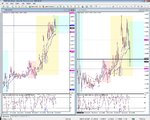jacknapier
Active member
- Messages
- 157
- Likes
- 2
I ditched stochastic's a long time ago. Recently, I pulled it up again to have another look at it, as I thought that maybe I had missed something. I didn't. I'm thoroughly convinced that I could draw a random squiggly line across the bottom of a chart and have just as reliable buy/sell signals. I wonder, if I could find a way to test that?



